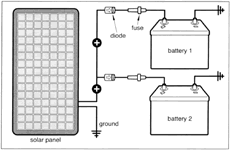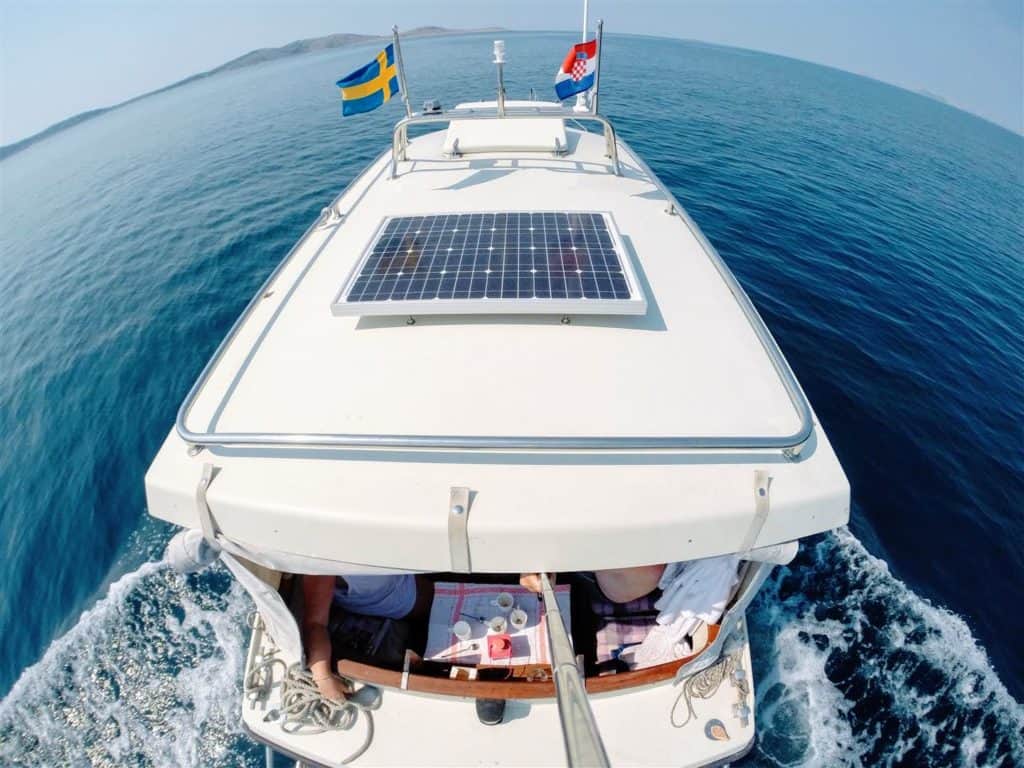Solar charging boat batteries harness sunlight to maintain and extend battery life. This eco-friendly method provides a constant power source for marine vessels.
Solar charging for boat batteries is an innovative and sustainable choice for mariners seeking to keep their craft powered while on the water. Utilizing solar panels to convert sunlight into electrical energy, this system ensures that your boat’s battery remains charged without the need for shore power or a generator.
Solar charging systems are a cost-effective solution that reduces reliance on fossil fuels and minimizes maintenance costs. Ideal for small boats, yachts, and fishing vessels, they are designed to withstand harsh marine environments. They offer the freedom to explore open waters with peace of mind from a reliable, renewable energy source. With advancements in solar technology, these systems are now more efficient and easier to install, making solar charging an increasingly popular choice among boaters worldwide.
Solar Charging Boat Battery
A solar charging board, equipped with photovoltaic cells, harnesses sunlight to charge batteries efficiently and sustainably. These boards are often used in various applications, from small gadgets to larger systems like camping gear or remote monitoring equipment. The solar panels convert sunlight into electrical energy, which is then stored in rechargeable batteries for later use. This eco-friendly solution reduces reliance on traditional power sources and is especially useful in off-grid locations. For optimal performance, it’s crucial to position the solar charging board in direct sunlight and regularly maintain the panels to ensure they remain clean and unobstructed.
Harnessing The Sun: Solar Charging For Boats
Welcome to the future of boating, where the sun’s power keeps you afloat. Solar charging for boats is revolutionizing how we enjoy our time on the water. With this eco-friendly technology, sailors and boaters harness solar energy to power their adventures. Let’s dive into the essentials of this green innovation.
The Basics Of Solar Power
Solar panels capture sunlight and convert it into electricity, a process called photovoltaic energy conversion. Boats use unique marine solar panels designed to withstand the harsh marine environment.
- Components: Solar panels, charge controller, batteries, and inverter form the core.
- Installation: Panels mount on decks or biminis, connecting to a charge controller.
- Maintenance: Solar systems require minimal upkeep, just routine cleaning.
Benefits Of Using Solar Energy On Water
Solar power offers unique advantages for boating enthusiasts.
| Benefit | Impact |
|---|---|
| Cost Savings | Reduces fuel and maintenance expenses over time. |
| Environmentally Friendly | Zero emissions, preserving water ecosystems. |
| Quiet Operation | Enjoy the sounds of nature without engine noise. |
| Energy Independence | Freedom from reliance on shore power and marinas. |
Embrace the sun’s power for your boating needs. The shift to solar can offer a seamless, sustainable experience on the water. Clear skies and sunny days mean more than just good weather; they signal endless energy for your nautical journeys.
))/2911814.json)
Credit: www.basspro.com
Components Of A Solar Boat Charging System
Embracing the sun’s power, solar charging systems for boat batteries have become a game-changer for marine enthusiasts. Such systems comprise several key components, each vital in harnessing, converting, and storing solar energy. Let’s dive into the core elements of a solar boat charging system.
Solar Panels: Types And Efficiency
Solar panels are the heart of a solar charging system. Two common types are monocrystalline and polycrystalline. Monocrystalline panels have a higher efficiency rate, converting more sunlight into electricity. Polycrystalline panels are more budget-friendly but slightly less efficient.
- Monocrystalline Panels: Higher efficiency, ideal for limited space.
- Polycrystalline Panels: Cost-effective, with a modest efficiency drop.
Charge Controllers: Ensuring Safe Charging
Charge controllers protect batteries from overcharging and excessive discharge. They also control the solar panels’ output voltage and current. There are two forms: Maximum Power Point Tracking (MPPT) and Pulse Width Modulation (PWM).
| Type | Description |
|---|---|
| PWM | Simpler technology, more affordable. |
| MPPT | It is more efficient and maximizes power extraction. |
Batteries: Storing Solar Energy
Batteries are essential for storing solar power for future use. Deep-cycle batteries are best suited for solar systems. They come in various types, such as lead-acid, AGM (Absorbed Glass Mat), and lithium. Lithium batteries offer long life and high performance but at a higher cost.
- Lead-acid: Tried and tested, economical choice.
- AGM: Maintenance-free, suitable for harsh conditions.
- Lithium: Lightweight, high efficiency, long lifespan.
Installation Tips For Solar Charging Systems
Embrace renewable energy on the water by installing a solar charging system for your boat battery. This tutorial breaks down the procedure into simple parts. Follow these tips to ensure your system runs smoothly, efficiently, and safely.
Choosing The Right Location For Panels
Maximize sun exposure by selecting the perfect spot for your solar panels. Consider these points:
- Avoid shaded areas.
- Ensure clear access to sunlight for most of the day.
- Mount panels away from walking paths to avoid damage.
- Angle panels correctly for your geographic location.
Wiring Considerations For Safety And Efficiency
Proper wiring is crucial for safety and system performance. Keep these tips in mind:
- Use marine-grade wires and connectors.
- Keep wire runs short and direct to minimize voltage drop.
- Protect wiring with conduit or tubing.
- Ensure all connections are tight and secure.
- Install a charge controller to prevent overcharging.
Maintenance For Optimal Performance
Regular maintenance boosts efficiency and prolongs your system’s life. Perform these tasks:
- Clean panels regularly to remove dirt and debris.
- Check connections for corrosion or wear.
- Inspect wiring for damage or exposure.
- Test the charge controller and replace it if it is faulty.
Solar Charging In Action: Case Studies
Embracing solar technology, boaters are now powering their vessels with the sun. This section looks into real-world scenarios where solar charging is making waves.
Personal Experiences Of Boaters
- I bought a 100W solar panel kit
- Installed on his 30-foot sailboat
- Battery stays charged on weekend trips
- Notices reduced generator use
- She uses a 50W panel for her small fishing boat
- Keeps fish finder and trolling motor powered
- Enjoys silent and clean energy
- Recommends solar for all-day fishing
Commercial Applications On The Water
| Tour Company | Solar Panels Used | Benefits |
|---|---|---|
| Green Waves | 500W system | Zero emissions, lower costs |
| Blue Sea Adventures | 1kW system | Extends tour times, attracts eco-conscious customers |
- Freight company integrates solar
- Installs 2kW panels on delivery boats
- Sees significant fuel savings
- Aims for a sustainable fleet
Navigating Challenges: Overcoming Obstacles
Embracing the power of the sun to charge boat batteries is a smart move. Yet, solar charging systems face unique challenges. Understanding these can ensure smooth sailing. Let’s explore how to tackle common issues.
Dealing With Shade And Cloud Cover
Shade and cloud cover can reduce solar charging efficiency. Boat owners often wonder how to manage this. Here are some tips:
- Install multiple panels: More panels catch more sun, even when some are shaded.
- Use MPPT controllers: These optimize energy harvest from each panel, regardless of shadows.
- Position panels smartly: Place panels where shade hits least, like on the mast or railings.
Solar Charging In Rough Waters
Rough waters pose a threat to solar panels. But solutions exist. Consider these methods:
| Solution | Benefit |
|---|---|
| Flexible panels | They bend with boat movements, reducing the risk of damage. |
| Secure mounting | Keeps panels in place, even in high waves. |
| Waterproof connections | It prevents short circuits from splashing water. |
Remember, a well-designed solar system takes the rough with the smooth. It keeps batteries charged, no matter the sea’s mood.
Eco-friendly Boating: Environmental Impact
Boating adventures should not harm our oceans. Solar charging boat batteries offer a clean energy solution. They keep the seas safe for future generations. This innovation leads to a greener boating experience.
Reducing Carbon Footprint
Traditional boat batteries rely on fossil fuels, which cause dangerous airborne pollutants. Switching to solar-charging boat batteries significantly cuts down these emissions. This minor adjustment has a significant effect.
- Zero emissions while sailing
- Solar power is renewable and clean
- Less reliance on non-renewable energy sources
Promoting Sustainable Boating Practices
Sustainable boating practices ensure healthy marine life. They also promote clean water. Solar charging boat batteries are a step towards sustainable boating.
- Use eco-friendly materials on your boat.
- Follow responsible waste disposal methods.
- Support marine conservation efforts.
Cost Analysis: Solar Charging Vs. Traditional Methods
Exploring the costs associated with solar charging for boat batteries reveals insights into its efficiency. Compare this to conventional charging methods to understand the potential financial impacts.
Initial Investment And Long-term Savings
Solar charging systems require an upfront investment. This covers solar panels, charge controllers, and installation. Yet, savings emerge over time. Solar energy is free after setup, slashing ongoing expenses.
- No fuel costs or maintenance charges like with generators
- Extended battery life due to consistent, gentle charging
| Expense | Solar Charging | Traditional Methods |
|---|---|---|
| Initial Setup | Higher | Lower |
| Ongoing Costs | Minimal | Recurring |
| Long-term Savings | Significant | Lower |
Government Incentives And Subsidies
Many regions offer incentives to adopt solar power. These can drastically reduce the initial investment.
- Research local subsidies
- Apply for solar investment tax credits
- Seek out renewable energy certificates
These programs make solar charging more accessible and affordable. They can offset costs significantly, tilting the balance in favour of solar.

Credit: www.ervsolar.com
Future Of Boating: Solar Innovations On The Horizon
The boating world is on the cusp of a revolution. Solar charging technology promises to transform how we power our aquatic adventures. Imagine gliding over the water, propelled by the power of the sun. This dream is fast becoming a reality. With solar innovations, the future of boating looks bright, clean, and endlessly sustainable.
Advancements In Solar Technology
Recent breakthroughs in solar tech are making waves in the boating industry. Panels are now more efficient and durable than ever. They can withstand harsh marine environments. These advancements mean boats can go farther with solar power alone. Here’s how solar panels have improved:
- Higher efficiency rates – converting more sunlight into energy
- Better materials – lasting longer in saltwater conditions
- Flexible designs – fitting various boat types and sizes
Integrating Solar Power With Other Renewable Energy Sources
Combining solar with other renewables leads to a powerhouse of sustainability. Hybrid systems offer reliability and extended range. They can harness wind and water currents alongside solar energy. Here’s a glance at the integration:
| Energy Source | Benefits |
|---|---|
| Solar Panels | Constant energy during daylight |
| Wind Turbines | Power when sailing or anchored |
| Hydro Generators | Energy from water movement |
This integration ensures boats have a steady energy supply. They can operate longer without relying solely on fossil fuels. The future of boating is not just about solar panels. It’s about creating a synergy between all available renewable resources.

Credit: www.boatus.com
Frequently Asked Questions
Can You Charge A Boat Battery With A Solar Panel?
Yes, you can charge a boat battery using a solar panel. However, a solar charge controller is required to regulate the charging process and protect the battery.
How Long Does Charge A Marine Battery With A Solar Panel Take?
Charging a marine battery with a solar panel typically takes 5-8 hours, depending on panel size and sunlight intensity.
How To Charge A Boat Battery Without Electricity?
Charge a boat battery without electricity using a solar charger, a hand-crank generator, or connecting it to a running vehicle’s alternator with jumper cables.
Can I use a deep-cycle marine battery for solar power?
Yes, you can use a deep-cycle marine battery for solar power storage. They are designed to handle frequent charging and discharging cycles.
Conclusion
Harnessing the sun’s power to charge boat batteries is an eco-friendly game changer. Solar technology allows mariners to sail cleaner and longer, lessening the environmental impact. Embrace this sustainable solution and set sail into a greener future powered by the endless energy of the sun.

I am a battery specialist writer and blogger based in the USA & UK . I have been working with battery power energy for 3 long years and I give trips on low battery power problem and solutions . I have a lot of experience with battery power and I share them here.

